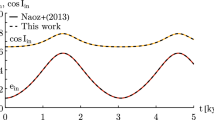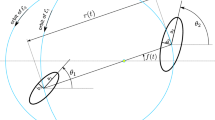Abstract
We derive a symplectic mapping model based on Hadjidemetriou’s method for the synchronous spin-orbit problem with and without the additional precession of the nodes. The mapping is derived from the averaged potential of the spin-orbit dynamical model and includes the main spin-orbit interactions, i.e. the non-zero obliquity and wobble motion of the rotating body. In addition the orbit of the perturbing body allows non-zero inclination and eccentricity. To obtain the equilibrium configuration we calculate the position and stability of the fixed points in the 1:1 spin-orbit resonance and relate them to the equilibria of the continuous system. We use the mapping equations to investigate the long-term stability close to the fixed point solutions of the mapping. We also apply the mapping method to the case of the moon Titan and validate the mapping approach by means of numerical integrations. The mapping model reproduces all the characteristics of Deprit’s model of free rotation as well as the dynamical features of Henrard’s averaged model of spin-orbit interaction with great precision.






Similar content being viewed by others
Notes
The superscripts \((o,s)\) which we are going to use separate the (o)rbital and (s)pin variables, respectively.
In contrast to D’Hoedt and Lemaitre (2004) we use the modified set of action-angle variables for both basic dynamical models since the modified actions are small quantities for small values of \(e,i\) and \(J,K\), thus suitable for perturbation theory.
A low order expansion of \(\bar{V}_G^{(2)}(P,p;P_4)\) can be found in the appendix B (in Supplementary Material appended to the online version of this article).
To be precise the average should be replaced by a canonical transformation from original to new mean variables. The transformation will be such to remove the dependency of the potential on the angle \(p_4\) to higher orders in a suitable small parameter.
In the Supplementary Material appended to the online version of this article.
Note, that the formulae are only correct up to order \(O(\gamma _1,\gamma _2)^2\), i.e. their product equals to one only up to \(O(\gamma _1,\gamma _2)^2\). We also checked the agreement of the second order formulae with the eigenvalues obtained with a numerical method in the range of values of the parameters \(A\simeq B\simeq C\).
References
Abdullaev, S.S.: A new integration method of Hamiltonian systems by symplectic maps. J. Phys. A 32, 2745–2766 (1999)
Baland, R.M., Van Hoolst, T., Yseboodth, M., Karatekin, O.: Titan’s obliquity as evidence for a subsurface ocean? A &A 530, A141 (2011)
Beletskii, V.V.: Resonance rotation of celestial bodies and Cassini’s laws. Celest. Mech. dyn. Astron. 6, 356–378 (1972)
Bills, B.G., Nimmo, F.: Rotational dynamics and internal structure of Titan. Icarus 214, 351–355 (2011)
Borderies, N., Yoder, C.F.: Phobos’ gravity field and its influence on its orbit and physical librations. A & A 233, 235–251 (1990)
Bouquillon, S., Kinoshita, H., Souchay, J.: Extension of Cassini’s laws. Celest. Mech. Dyn. Astron. 86, 29–57 (2003)
Breiter, S., Buciora, M.: Explicit symplectic integrator for rotating satellites. Celest. Mech. Dyn. Astron. 77, 127–137 (2000)
Cachucho, F., Cincotta, P.M., Ferraz-Mello, S.: Chirikov diffusion in the asteroidal three-body resonance (5–2-2). Celest. Mech. Dyn. Astron. 108, 35–58 (2010)
Celletti, A., Chierchia, L.: Measures of basin of attraction in spin-orbit dynamics. Celest. Mech. Dyn. Astron. 101, 159–170 (2008)
Chirikov, B.V.: A universal instability of many-dimensional oscillator systems. Phys. Rep. 52, 263 (1979)
Colombo, G.: Cassini’s second and third laws. Astron. J. 71, 861–891 (1966)
Deprit, A.: Free rotation of a rigid body studied in the phase plane. Am. J. Phys. 35, 424–428 (1967)
D’Hoedt, S., Lemaitre, A.: The spin-orbit resonant rotation of Mercury: a two degree of freedom Hamiltonian model. Celest. Mech. Dyn. Astron. 89, 267–283 (2004)
Ferraz-Mello, S.: A symplectic mapping approach to the study of the stochasticity in asteroidal resonances. Celest. Mech. Dyn. Astron. 65, 421–437 (1996)
Froeschlé, C.: Mappings in astrodynamics. In: Ferraz-Mello, S. (ed.) Chaos, Resonance and Collective Dynamical Phenomena in the Solar System, pp. 375–390 (1992)
Goldreich, P., Peale, S.: Spin-orbit coupling in the solar system. Astron. J. 71, 425–437 (1966)
Hadjidemetriou, J.: Mapping models for Hamiltonian systems with application to resonant asteroid motion. In: Roy, A. (ed) Predictability Stability and Chaos in N-Body, Dynamical Systems, pp. 157–175 (1991)
Hadjidemetriou, J.: A hyperbolic twist mapping model for the study of asteroid orbits near the 3:1 resonance. ZAMP 37, 776–792 (1992)
Hadjidemetriou, J.: Symplectic mappings. In: Ferraz-Mello, S. et al. (eds.) Dynamics, Ephemerides and Astrometry of the Solar System, IAU Symp 172, 255–266 (1996)
Hadjidemetriou, J.: A symplectic mapping model as a tool to understand the dynamics of 2/1 resonant asteroid motion. Celest. Mech. Dyn. Astron. 73, 65–76 (1999)
Henrard, J.: The rotation of Io. Icarus 178, 144–153 (2005)
Henrard, J., Schwanen, G.: Rotation of synchronous satellites. Celest. Mech. Dyn. Astron. 89, 181–200 (2004)
Iess, L., Rappaport, J., Jacobson, A., Racioppa, P., Stevenson, D.J., Tortora, P., Armstrong, J.W., Asmar, S.W.: Gravity field shape and moment of inertia of Titan. Science 327, 1367–1369 (2010)
Kinoshita, H.: Theory of the rotation of the rigid earth. Celest. Mech. Dyn. Astron. 15, 277–326 (1977)
Laskar, J., Robutel, P.: High order symplectic integrators for perturbed Hamiltonian systems. Celest. Mech. Dyn. Astron. 80, 39–62 (2001)
Lemaitre, A., D’Hoedt, S., Rambaux, N.: The 3:2 spin-orbit resonant motion of mercury. Celest. Mech. Dyn. Astron. 95, 213–224 (2006)
Lhotka, C.: Dynamics expansion points: an extension to Hadjidemetriou’s mapping method. Celest. Mech. Dyn. Astron. 104, 175–189 (2009)
Noyelles, B., Lemaitre, A., Vienne, A.: Titan’s rotation—a 3-dimensional theory. A &A 478, 959–970 (2008)
Peale, S.J.: Generalized Cassini’s laws. Astron. J. 74, 483–489 (1969)
Stumpff, K.: Himmelsmechanik Band I. Deutscher Verlag der Wissenschaften, Berlin (1959)
Touma, J., Wisdom, J.: Lie-Poisson integrators for rigid body dynamics in the solar system. Astron. J. 107, 1189–1202 (1994)
Vienne, A., Duriez, L.: TASS1.6: ephemerides of the major Saturnian satellites. A &A 297, 588–605 (1995)
Ward, W.R.: Tidal friction and generalized Cassini’s laws in the solar system. Astron. J. 80, 64–70 (1975)
Wisdom, J.: The origin of the kirkwood gaps: a mapping for asteroidal motion near the 3/1 commensurability. Astron. J. 87, 577–593 (1982)
Wisdom, J.: Chaotic behaviour and the origin of the 3/1 Kirkwood gap. Icarus 56, 51–74 (1983)
Wisdom, J., Holman, M.: Symplectic maps for the n-body problem. Astron. J. 102, 1528–1538 (1991)
Wolfram, S.: Mathematica, V8. Wolfram Research, Champaign, IL USA (2012)
Yoshida, H.: Recent progress in the theory and application of symplectic integrators. Celest. Mech. Dyn. Astron. 56, 27–43 (1993)
Acknowledgments
The author thanks A. Lemaitre and B. Noyelles for fruitful discussions and for reading the manuscript carefully. B. Noyelles provided an independent software to integrate the un-averaged problem to check the numerical integrations. C. Lhotka was financially supported by the contract Prodex C90253 ROMEO from BELSPO.
Author information
Authors and Affiliations
Corresponding author
Electronic supplementary material
Below is the link to the electronic supplementary material.
Appendix A
Appendix A
The rotation matrices, used in the present paper, are defined following the convention:
where \(R_j=R_j(\psi )\) with \(j=1,2,3\) and where we used the abbrevations \(c=\cos (\psi )\) and \(s=\sin (\psi )\).
Rights and permissions
About this article
Cite this article
Lhotka, C. A symplectic mapping for the synchronous spin-orbit problem. Celest Mech Dyn Astr 115, 405–426 (2013). https://doi.org/10.1007/s10569-012-9464-5
Received:
Revised:
Accepted:
Published:
Issue Date:
DOI: https://doi.org/10.1007/s10569-012-9464-5




